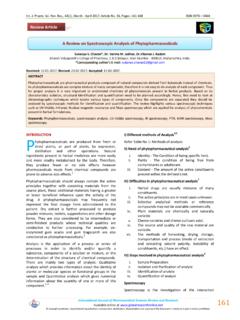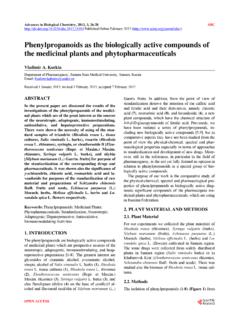Transcription of Fundamentals of Pharmacognosy and Phytotherapy
1 FUNDAMENTALSOFPHARMACOGNOSYANDPHYTOTHERA PYC ommissioning Editor:Pauline GrahamDevelopment Editor:Fiona ConnProject Manager:Sruthi ViswamDesign Direction:Charles GrayIllustration Manager:Merlyn HarveyFUNDAMENTALSOFPHARMACOGNOSYANDPHYT OTHERAPYSECOND EDITIONM ichael HeinrichDr rer nat habil MA(WSU) Dipl. Biol. FLSP rofessor and Head, Centre for Pharmacognosy and Phytotherapy , UCL School of Pharmacy,University of London, London, UKJoanne BarnesBPharm PhD MRPharmS FLSA ssociate Professor in herbal Medicines, School of Pharmacy, University of Auckland, Auckland, New ZealandSimon GibbonsBSc PhD CChem CSci FRSC FLSP rofessor of Phytochemistry, Department of Pharmaceutical and Biological Chemistry,UCL School of Pharmacy, University of London, London, UKElizabeth M.
2 WilliamsonBSc(Pharm) PhD MRPharmS FLSP rofessor of Pharmacy, School of Pharmacy, University of Reading, UKForewordA. Douglas KinghornBPharm MSc PhD DSc FRPharmS FAAAS FAAPS FLS FSPP rofessor and Jack L. Beal Chair of Natural Products Chemistry and Pharmacognosy , College of Pharmacy,The Ohio State University, Columbus, Ohio, USAE pilogueJ. David PhillipsonDSc PhD MSc BSc(Pharm) FRPharmS FLSE meritus Professor of Pharmacognosy , Centre for Pharmacognosy and Phytotherapy , School of Pharmacy,University of London, London, UKIllustrations byDebbie Maizels and Simon GibbonsEDINBURGH LONDON NEW YORK OXFORD PHILADELPHIA ST LOUIS SYDNEY TORONTO 2012 2012 Elsevier Ltd.
3 All rights part of this publication may be reproduced or transmitted in any form or by any means, electronic ormechanical, including photocopying, recording, or any information storage and retrieval system,without permission in writing from the publisher. Details on how to seek permission, furtherinformation about the Publisher s permissions policies and our arrangements with organizations suchas the Copyright Clearance Center and the Copyright Licensing Agency, can be found at our book and the individual contributions contained in it are protected under copyright by thePublisher (other than as may be noted herein).
4 First edition 2004 Second edition 2012 ISBN 978-0-7020-3388-9 British Library Cataloguing in Publication DataA catalogue record for this book is available from the British LibraryLibrary of Congress Cataloging in Publication DataA catalog record for this book is available from the Library of CongressNoticesKnowledge and best practice in this field are constantly changing. As new research and experiencebroaden our understanding, changes in research methods, professional practices, or medical treatmentmay become and researchers must always rely on their own experience and knowledge in evaluatingand using any information, methods, compounds, or experiments described herein.
5 In using suchinformation or methods they should be mindful of their own safety and the safety of others, includingparties for whom they have a professional respect to any drug or pharmaceutical products identified, readers are advised to check the mostcurrent information provided (i) on procedures featured or (ii) by the manufacturer of each product tobe administered, to verify the recommended dose or formula, the method and duration ofadministration, and contraindications. It is the responsibility of practitioners, relying on their ownexperience and knowledge of their patients, to make diagnoses, to determine dosages and the besttreatment for each individual patient, and to take all appropriate safety the fullest extent of the law, neither the Publisher nor the authors, contributors, or editors, assumeany liability for any injury and/or damage to persons or property as a matter of products liability,negligence or otherwise, or from any use or operation of any methods, products, instructions.
6 Or ideascontained in the material 'spolicy is to usepaper manufacturedfrom sustainable forestsPrinted in ChinavContentsForeword viiA. Douglas KinghornPreface ixPART A Fundamentals OFPHARMACOGNOSY1 SECTION 1 Phytotherapy of plants in modern pharmacyand medicine and its history: people,plants and natural products 10 SECTION 2 BASIC PLANT principles of botany: morphologyand systematics yielding importantphytopharmaceuticals and ethnopharmacy 49 SECTION 3 NATURAL PRODUCT product chemistry in natural product chemistry natural products 129 SECTION 4 PHARMACEUTICALS ANDNUTRACEUTICALS DERIVED FROM , standardization and qualitycontrol of herbal constituents makes phytomedicines unique?
7 166 SECTION 5 MEDICINAL PLANTS IN SELECTEDHEALTHCARE systems of herbal medicine and Alternative medicine 189 PART B IMPORTANT NATURAL PRODUCTSAND PHYTOMEDICINES USED INPHARMACY AND gastrointestinal and biliary system cardiovascular system respiratory system central nervous system diseases endocrine system reproductive tract musculoskeletal system skin eye , nose and orthopharynx supportive therapies for stress,ageing, cancer and debility 296 Epilogue a personal view 304J. David PhillipsonIndex 311viContentsviiForewordWorldwide, drugs derived from organisms continueto be important for the treatment and prevention ofmany diseases.
8 Pharmacognosy , which is defined inthis book as the science of biogenic or nature-derivedpharmaceuticals and poisons , has been an estab-lished basic pharmaceutical science that has beentaught in institutions of pharmacy education forabout two centuries. This subject area has changedconsiderably since its initiation, having metamor-phosed from a largely descriptive botanical andmycological field in the late 19th and early 20thcentu-ries, tohavingmoreof a chemicaland biological focuswithin the last 50 years or so. Today, pharmacognosyembraces the scientific study of compounds fromplants, animals and microbes, of both terrestrial andmarine origin, and has evolved relatively recently toalso include Phytotherapy and nutraceuticals.
9 Theteaching of Pharmacognosy has become even morerelevant than previously over the last decade, as aresult of the increasing use of herbal remedies (phyto-medicines) by the public in Europe, North Americaand Australasia. When entering a pharmacy todayit becomes apparent that considerable shelf space isdevoted to a selection of herbs , to a degree whichwould have been quite unimaginable even 20 yearsago. If the United States is taken as an example, com-munity pharmacists nowadays have to deal with arather bewildering array of botanical dietary supple-ments ,manyofwhichwere introducedsoonafterthepassage of the Dietary Supplement Health and Edu-cation Act of 1994.
10 In a major National Health Inter-view Survey, commissioned by the Centers forDisease Control and Prevention (CDC), it was foundthat in 2007 about 20% of the US adult populationconsumed nonvitamin, nonmineral natural pro-ducts , amounting to the sum of $ billion. There-fore, societal interest in Pharmacognosy is likely toincrease in the future as the biochemical role of phy-tomedicines, nutraceuticals and natural drugs ingeneral becomes more clearly second edition of this volume,FundamentalsofPharmacognosyandPhy totherapy, byMichaelHeinrich,Joanne Barnes, Simon Gibbons and ElizabethWilliamson, aims to provide a contemporary andin-depth perspective of natural product drugs usedin the practice of pharmacy.










